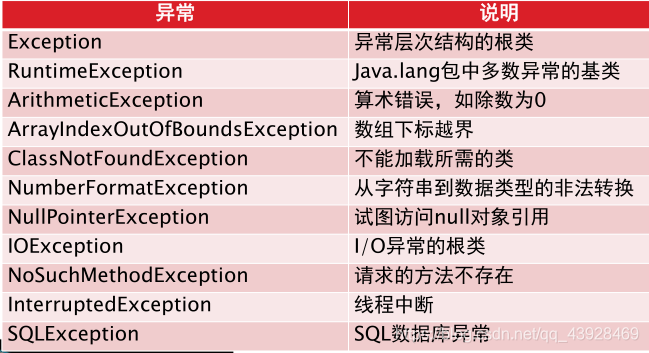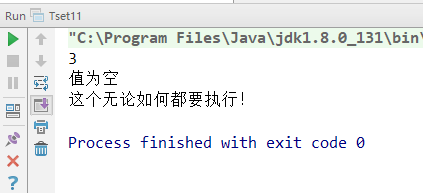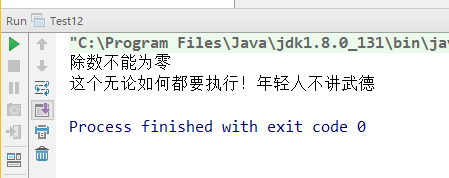Java面向对象基础–异常处理(try catch throw throws finally)
异常不是错误,是在运行过程中代码产生的一种例外。
所有的异常类是从 java.lang.Exception 类继承的子类。
Exception 类是 Throwable 类的子类。除了Exception类外,Throwable还有一个子类Error 。
Error 用来指示运行时环境发生的错误。

常见异常类型:

关键字:try catch throw throws finally
try catch finally
- 使用 try 和 catch 关键字可以捕获异常。try/catch 代码块放在异常可能发生的地方。
- 发生异常时,直接进入catch
- finally 关键字用来创建在 try 代码块后面执行的代码块。无论是否发生异常,finally 代码块中的代码总会被执行。
- 一个try 代码块后面跟随多个 catch 代码块的情况就叫多重捕获。多重catch最后一个异常一定是exception。
例1:
public class Tset11 {
public static void main(String[] args) {
try {
int number=5/0;
System.out.println(number);
String aaa=null;
System.out.println(aaa.length());
}catch (ArithmeticException e){
System.out.println("除数不能为0!!!");
}catch (NullPointerException e){
System.out.println("值为空");
}
finally {
System.out.println("这个无论如何都要执行!");
}
}
}
代码分析:
当第一段代码报错时,会直接进入catch进行判断,看其符合哪个异常,然后输出此异常,最后执行finally
运行结果如下:

例2:
public class Tset11 {
public static void main(String[] args) {
try {
int number=6/2;
System.out.println(number);
String aaa=null;
System.out.println(aaa.length());
}catch (ArithmeticException e){
System.out.println("除数不能为0!!!");
}catch (NullPointerException e){
System.out.println("值为空");
}
finally {
System.out.println("这个无论如何都要执行!");
}
}
}
代码分析:
当第一段代码可以执行时,会执行第二段代码,进而报错执行catch,找到相对应的异常执行,最后执行finally
代码运行结果:

例3、嵌套try-catch
public class Test12 {
public static void main(String[] args) {
try {
try {
int number=6/0;
System.out.println(number);
}catch (NullPointerException e){
System.out.println("值为空");
}
}catch (ArithmeticException e){
System.out.println("除数不能为零");
}catch (Exception e){
System.out.println(e);
}
finally {
System.out.println("这个无论如何都要执行!年轻人不讲武德");
}
}
}
代码分析:
try-catch嵌套和if嵌套一样,本例代码在内部try-catch并没有发现异常,所以会执行外部try-catch,最后执行finally
运行结果如下:

throw throws
如果一个方法没有捕获到一个检查性异常,那么该方法必须使用 throws 关键字来声明,跟在方法后。也可以使用 throw 关键字抛出一个异常,无论它是新实例化的还是刚捕获到的。
public class Test13 extends Exception{
public Test13() {
}
public Test13(String message) {
super(message);
}
}
public class Test13_1 extends Test13{
public static void main(String[] args) {
try {
show();
} catch (Test13 test13) {
test13.printStackTrace();
}
}
public static void show() throws Test13{
if (2>1){
throw new Test13("哈哈哈哈哈");
}
}
}
代码分析:
自定义一个异常,只有在满足条件的时候才会输出
代码实现如下:
